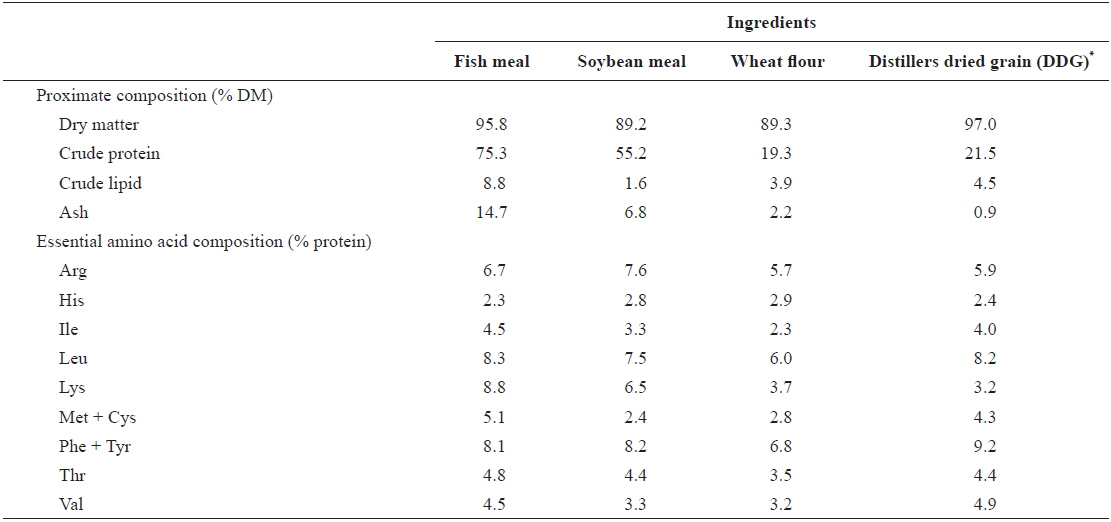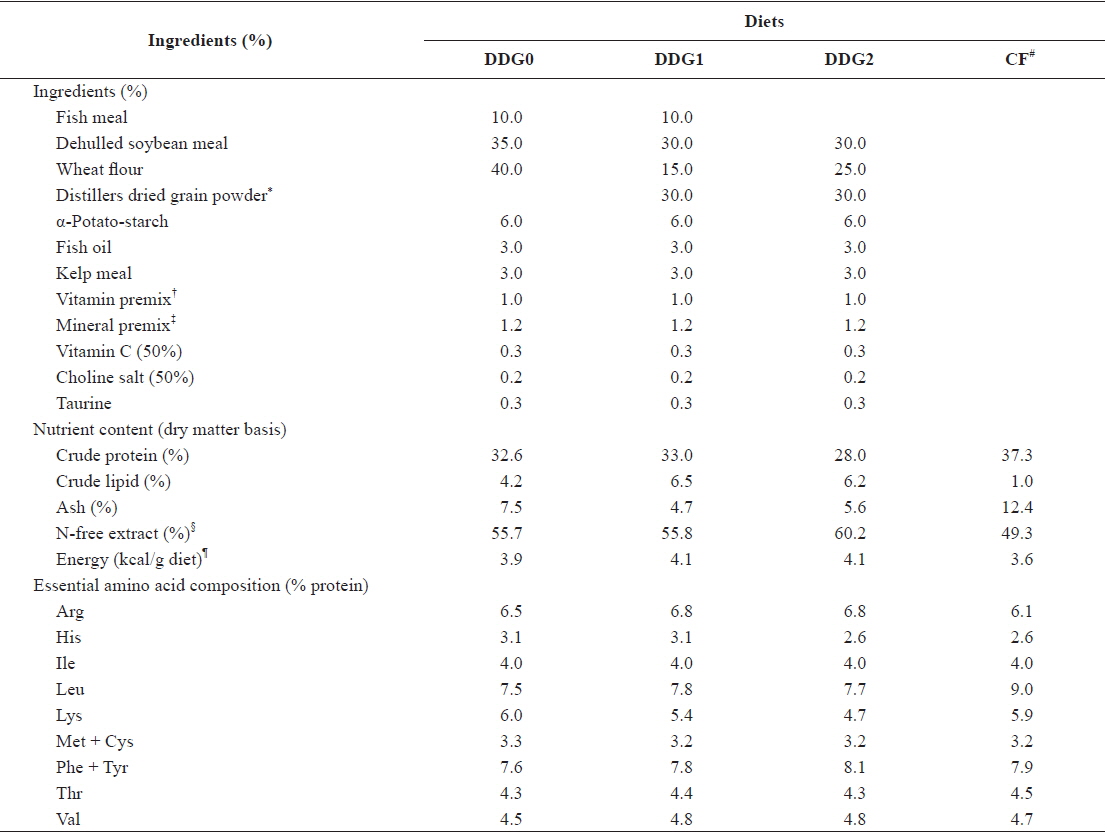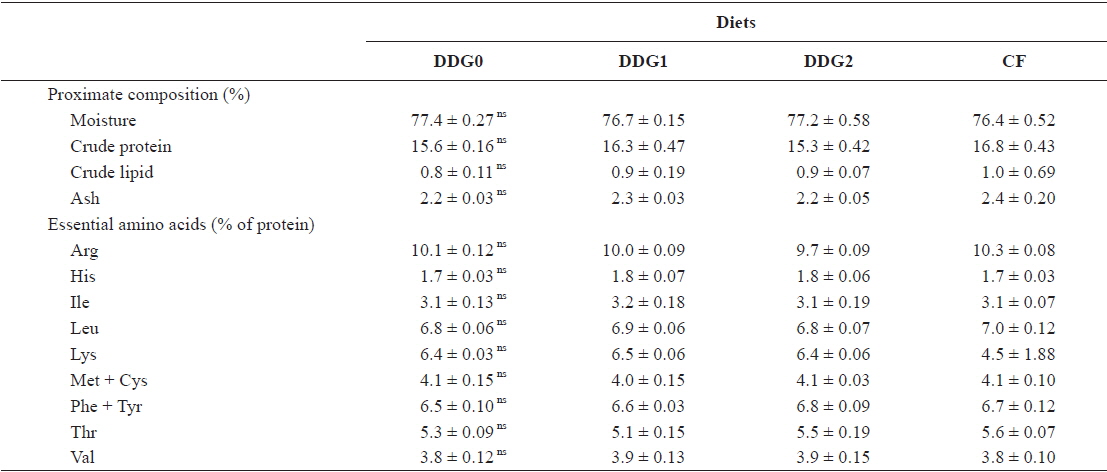



Abalone
Distillers dried grain (DDG) is a cereal by-product from yeast fermentation of grains pertaining to ethanol production (He et al., 2013). Usually, DDG may be fed to ruminants, poultry and swine (Whitney et al., 2006; Światkiewicz and Koreleski, 2008). DDG is palatable to fish and it is more affordable compared to fishmeal, soybean meal and wheat flour, which is commonly used in aquaculture diets (He et al., 2013; Rahman et al., 2015). Optimum level of DDG in fish diets seemed to vary depending on the fish species, type of ingredient replaced and the source of grain used for DDG production. However, limited information is available on the effect of dietary DDG from rice as an alternative ingredient for juvenile abalone,
The successful culture of this species depends on proper nutrition and rapid growth. To keep a productive and cost-effective abalone culture operation, a reliable feed must be produced where it improves growth and survival of the abalone under culture. Based on our results (Lee 2004), practical feed formulation has been studied to improve aquaculture production of
Essential amino acid and proximate composition of major ingredients used in the experimental diets are presented in Table 1. The ingredient and nutrient content of the experimental diets are presented in Table 2. Three isonitrogenous experimental diets were formulated to contain 0% (DDG0), 30% DDG (DDG1) replacing wheat flour and 30% DDG (DDG2) replacing fishmeal and wheat flour. A commercial feed (CF) was also compared with the experimental diets. Fish meal was used as the primary protein source and fish oil was used as the lipid source. DDG was produced by filtration of an aqueous mixture of fermented rice with

Composition of proximate and essential amino acid of the major ingredients of experimental diets
[Table 2.] Ingredients and nutrients content of experimental diets

Ingredients and nutrients content of experimental diets
>
Experimental animal and feeding experiment
Juvenile abalones were produced by the Gangwon Province Fisheries Resources Institute (Gangneung 210-860, Korea) and acclimated to a laboratory flow-through aquarium system for 2 weeks. During this conditioning period, abalones were fed a commercial feed. After the conditioning period, juvenile abalones (average body weight, 0.6 ± 0.01 g) were randomly allocated to twelve 50-L rectangular plastic tanks (40 L of water each) in a seawater flow-through system at a density of 50 animals per tank. Three replicate groups of abalone were fed one of the experimental diets at a feeding rate of 5% body weight per day for 14 weeks. Before feeding, uneaten food in each aquarium were removed by siphoning. Photoperiod was left at the natural condition and air was provided in each aquarium during feeding trial. The water temperature was maintained at 19.4℃ and filter seawater was supplied in each aquarium at a flow rate of 1 L/min. At the initiation and the termination of the experiment, an electric balance collectively weighed abalones in each aquarium after being fasted for 24 h.
>
Sample collections and chemical methods
All surviving abalone at the end of the feeding experiment were sampled after 24 h starvations, and stored at -25℃ for proximate analysis. Proximate compositions of the soft body of abalones were analyzed according to standard method (AOAC, 1995). Crude protein contents were determined by Kjeldahl method using an Auto Kjeldahl System (Buchi, Flawil, Switzerland) and moisture contents were measured by oven drying at 105℃ for 6 h. Crude lipids were determined by ether-extraction method, and ash contents were determined by a muffle furnace at 600℃ for 4 h. Amino acid compositions in the experimental diets and whole body of abalones were performed with acid hydrolysis with 6 N HCL (reflux for 23 h at 110℃) followed by using an automatic amino acid analyzer (Hitachi, Tokyo, Japan).
The data were subjected to one-way analysis of variance (ANOVA) using the SPSS version 18.0 (SPSS Inc., Chicago, IL, USA). Significant differences (
Growth performances of juvenile abalone fed the experimental diets are presented in Table 3. The highest survival was observed in abalone fed the DDG2 diet, which was higher than the DDG0 diet. No significant differences were identified in weight gain, shell length, shell width and soft body weight among the groups (
[Table 3.] Growth performance of juvenile abalone fed the experimental diets for 14 weeks

Growth performance of juvenile abalone fed the experimental diets for 14 weeks

Proximate and essential amino acid composition of the soft-whole body in juvenile abalone fed the experimental diets for 14 weeks
The present results demonstrate that the dietary inclusion of rice DDG, at a level of 30% DDG, is sufficient for the growth of juvenile abalone. No significant difference in weight gain of abalone fed diets containing DDG in this study indicated that DDG could substitute for fishmeal and wheat flour in the diet without retardation of the abalone growth. Several authors have noticed the satisfactory growth performance in tilapia when fed diets containing corn-based DDG replacing fish meal (Coyle et al., 2004; Schaeffer et al., 2009). A combination of corn-based DDG and soybean meal might have been incorporated in yellow perch diet without negative effects upon growth (Schaeffer et al., 2011). In rainbow trout diets, Cheng and Hardy (2004) stated that corn-based DDG could be utilized up to 22.5% inclusion without negative effects on the growth performance. Result of this study is in agreement with other studies (Tidwell et al., 1990; Webster et al., 1992; Robinson and Li, 2008) showing that 30-35% corn-based DDG could be used to partially replace soybean meal in channel catfish diets. In the present study, weight gain of juvenile abalone fed diets containing at a level of 30% DDG were not different compared to the control group. This is considered to be the main reason for removing anti-nutritional factors of DDG by means of fermentation. Fermentation of plant ingredients such as soybean meal has been reported to improve their nutritional value (Yamamoto et al., 2010). Many scientific studies suggested that fermentation improves the protein digestibility of plant ingredients (Bairagi et al., 2002; 2004; Ramachandran and Ray, 2004). During the production of DDG from rice, yeasts were used in order to facilitate the fermentation method. DDG contains substantial amounts of yeast cells, which are rich in protein and B-complex vitamins (Lim et al., 2007). Some studies with pacu (Ozório et al., 2010) and tilapia (Lara-Flores et al., 2003) reported good growth with the dietary inclusion of yeast.
In the present study, abalone fed diets containing DDG was not different among the treatments in whole body proximate composition. Our earlier studies have revealed that whole body proximate composition of juvenile sea cucumber was not affected by dietary level of rice-based DDG (Seo et al., 2011; Choi et al., 2013).
Formulated feeds for abalone in the present research may contain enough protein, carbohydrates and essential amino acids for their particular proper nutrient requirements. Cho et al. (2008) reported good growth of abalone when fed the diets containing fish meal and soybean meal. It has been reported that abalone appear to have great potential for using carbohydrate pertaining to energy and may be intended for other nutritional purposes as well (Lee, 2004). Supplementation of dietary DDG might provide not only protein but also energy for body growth of juvenile
The results of this experiment suggests that dietary DDG is good ingredient to replace fish meal and wheat flour and could be used at a level of 30% in the formulated diet without incurring negative effects on the growth performance of juvenile abalone,






